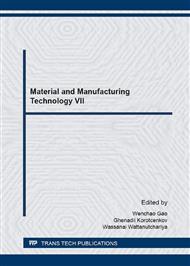p.33
p.38
p.45
p.50
p.55
p.62
p.67
p.73
p.81
Microstructure and Wear Resistance of Hard-Facing Weld Metal on JIS-S50C Carbon Steel in Agricultural Machine Parts
Abstract:
Hard-facing welding is one of the repairing methods for increasing hard metal on the agricultural machine part surfaces that caused by the wear mechanism. To this date, the investigation of an optimized welding process parameter that could produce high hardness and wear resistance of the hard-facing layer is still being developed and performed. This paper aims to study the effects of hard-facing welding layer on mechanical properties and microstructure of hard-facing weld metal on JIS-50C carbon steel. The summarized results are as follows: (a) an increase of hard-facing layer affected to increase the hardness of the layer, (b) the hardness of the welds showed a maximum hardness of about 750 HV at a top surface of 3rd welds layers with no-buffering layer and showed the minimum hardness of about 225 HV at a base metal, (c) microstructure investigation showed that the increase of the phase that contained higher chromium, molybdenum and manganese affected the increase of the hardness and the wear resistance of the weld metal, (d) The minimum mass loss of 0.2559 mg/m could be found when a welding current of 100A, non-buffering layer and 3 layers of hard-facing weld metal were applied, and (e) the buffering layer was able to produce a sound weld metal and might not be suited for the hard-facing welding of the medium carbon steel because it produced the dilution effect that deteriorated the mechanical properties of the weld metal.
Info:
Periodical:
Pages:
55-61
Citation:
Online since:
September 2016
Keywords:
Price:
Сopyright:
© 2016 Trans Tech Publications Ltd. All Rights Reserved
Share:
Citation:


